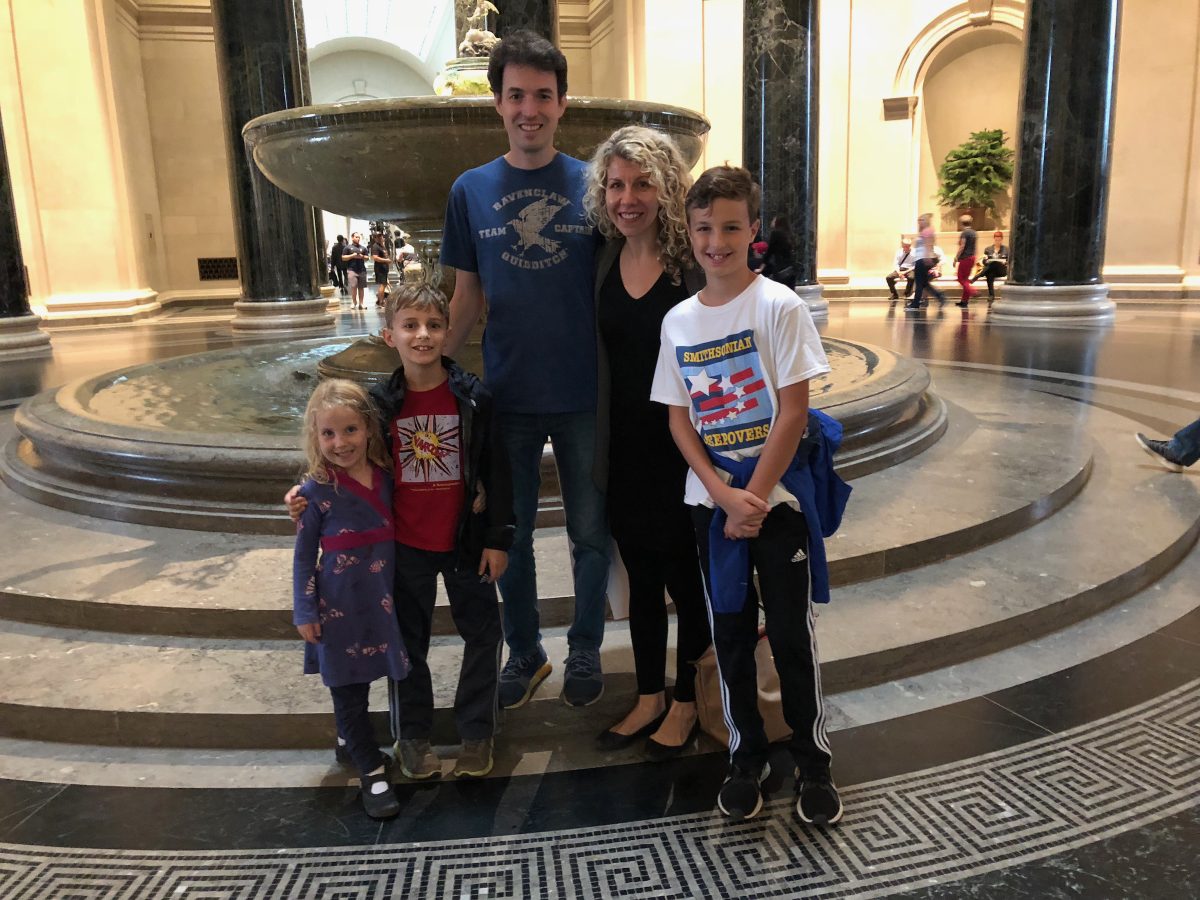
Art has always been a solace for me. One has only to spend time with a Frida Kahlo or a Rembrandt painting to be reminded that our suffering is universal and timeless. Communing with art has gotten me through breakups, job disappointments, and deaths. What I learned over the next few months was that studying art history could also ease my family through the pandemic’s seemingly unending period of anxiety and the unknown.
My husband Steven has a genetic disorder that caused a life-threatening reaction to his lymphoma treatment two years ago, and it also puts him at high risk for severe illness from COVID. Consequently, our family of five quarantined strictly over the past 16 months. Last summer, as his work-level increased, he went for days without smiling. My PTSD kicked in each time I saw his neck muscles strain. Looking for ways to reduce his stress felt like something I could do to keep his cancer at bay.
A solution presented itself in October, when my 13-year-old asked me to help fill a knowledge void for his virtual quiz bowl team: art history. James knows I once worked in art museums as a development associate and have drafted an art-themed novel. Throughout the years, I’d subjected him and his siblings to regular museum visits with the promise of gelato at the end. I saw an opportunity not only to increase all my children’s art history IQ, but to help Steven unwind.
Steven says he fell in love with me the day I gave him a five-hour tour of the National Gallery of Art, that I opened up new worlds beyond his all-consuming study of medicine. He seemed excited by the idea of a nightly escape through art lectures during quarantine. Our seven-year-old, Rebecca was sold on the idea, too. But 11-year-old Marc, who has no poker face, was not.
“Art is for fancy people,” he said. “We’re not fancy.”
I knew what he meant. We’re decidedly the jeans-and-sneakers sort, and art displayed in marble buildings, that commands hundreds of millions of dollars at auctions, can be intimidating. But much of “high art” has messages about social justice and can stimulate creativity and empathy. It wasn’t necessary for my children to love art, but I wanted to make it more accessible for them.

“No, we’re not,” I said. “But art is for everyone.”
Marc remained unconvinced, but he was overruled. Over the next several months, I gave 157 10-minute lectures — starting with the Paleolithic fertility figurine “Venus of Willendorf” (ca. 28,000–25,000 BCE)and ending with Kara Walker’s large sphynx-like sculpture, “A Subtlety” (2014) and Cai Guo-Qiang’s gunpowder-blasted canvases. Marc would drop his head on the table if he was bored — criticism in its purest form. I learned to choose facts that engaged everyone, that made him lift his head to at least glance at the image I held aloft on my iPad, such as:
- The color purple used in Byzantine mosaics was created from the mucus secreted by snails.
- Marcel Duchamp proclaimed that a real urinal — his “readymade” “Fountain” (1917) — was art.
- An image of Ansel Adams’s photograph, “The Tetons and the Snake River,” (1942) selected by Carl Sagan to represent earth’s terrain, was placed aboard the Voyager 1 and 2 spacecraft, as part of an information packet for any extraterrestrials approaching our ‘hood.
My syllabus had hits and misses. Jacques-Louis David’s “Napoleon Crossing the Alps” (1801–1805) inspired a lively discussion about propaganda and how my family members would want to be represented in art. But fluffy Rococo and overly sentimental Pre-Raphaelite paintings received collective yawns from my crew.
Hands down, the artwork that most captured Marc’s attention was Amedeo Modigliani’s double portrait, “Jacques and Berthe Lipchitz” (1916). Marc reveled in telling everyone about this painting, perhaps less for the image and more for the opportunity to emphasize the second syllable of the subjects’ last name with a rascally grin. Marc’s reactions to my art talks made Steven laugh, a sound that sends my heart cartwheeling. The return of his smile meant my project was succeeding.

There were other unexpected benefits. Not only did James begin to dominate art topics during quiz bowl practices, but my kids can now identify any artwork the Animal Crossing character Redd the fox sells — all are based on real-world paintings and sculptures (i.e. the “Solemn Painting” is after “Las Meninas” (1656) by Diego Velázquez). Marc and Rebecca also correctly answered several questions in the Vincent Van Gogh and Georgia O’Keeffe categories of Jeopardy. Suddenly, art had relevance and value for them.
I can’t guarantee my children will retain these art facts in the future. But years from now, they may laugh at the memory of their mutual grumpiness that I gave yet another art talk when they would have preferred to spend the entire meal discussing anything else.
Now that Steven, James, and I are vaccinated, and the world is opening up again, new stimuli have replaced my art talks. Recently, Marc admitted they “weren’t as bad as he thought they’d be.” This felt like high praise. No matter how monotonous or frustrating our quarantine lives became, the art talks provided a sustaining ritual, something to calm, amuse, and bond our family. And who knows, maybe now I’ll be able to convince my family to visit another art museum without bribing them with gelato.
0 Commentaires